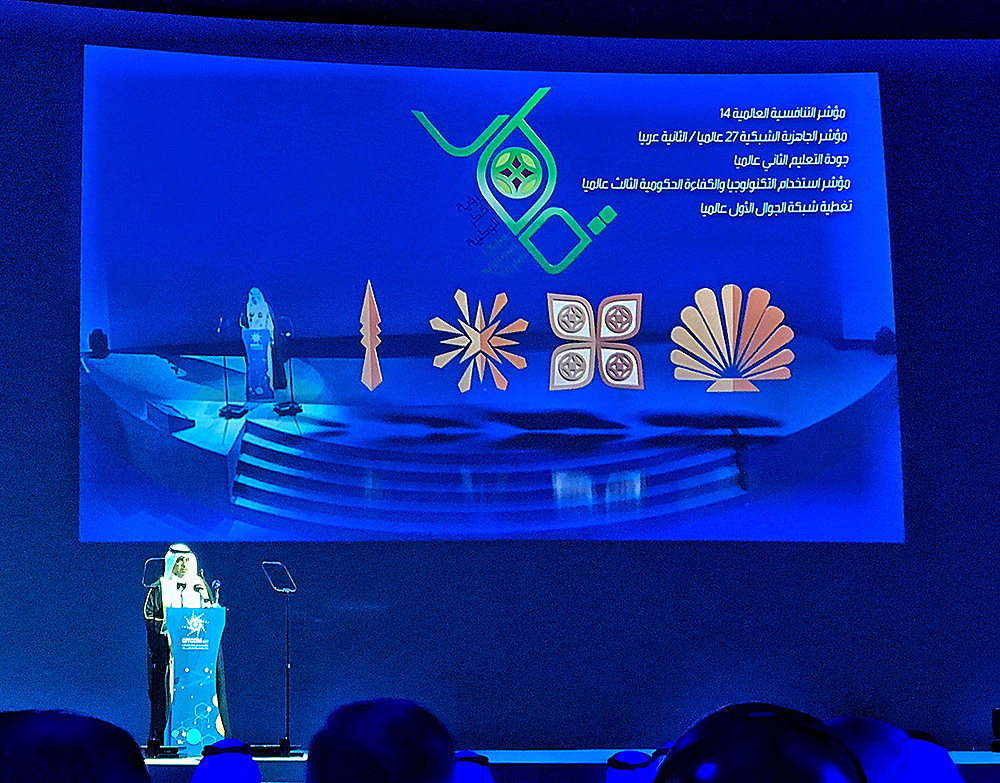 This week I’ve been in Doha, Qatar for the QITCOM 2017. It’s the fourth edition of Qatar’s information and communication technology exhibition and conference and Qatar’s biggest digital event, organized at the Qatar National Convention Center, under the theme “Qatar Towards a Smart Future.”
This week I’ve been in Doha, Qatar for the QITCOM 2017. It’s the fourth edition of Qatar’s information and communication technology exhibition and conference and Qatar’s biggest digital event, organized at the Qatar National Convention Center, under the theme “Qatar Towards a Smart Future.”
 The conference opened with some of the most impressive audio-visual effects I’ve ever seen at a conference, with a huge screen that wrapped around the auditorium, and striking animated, augmented-reality slides with 3D graphics that appeared to cast shadows on the stage next to the presenters.
The conference opened with some of the most impressive audio-visual effects I’ve ever seen at a conference, with a huge screen that wrapped around the auditorium, and striking animated, augmented-reality slides with 3D graphics that appeared to cast shadows on the stage next to the presenters.
I participated in the panel session on Innovative Ideas Transforming Transportation and Logistics, hosted by Mark Spelman of the World Economic Forum.
 Transport & Logistics Panel at QITCOM 2017. Photo by Pedro Pereira
Transport & Logistics Panel at QITCOM 2017. Photo by Pedro Pereira
The panel discussed how the way in which we move people and goods around is changing thanks to with data and infrastructure transformation.
I believe that it’s now clear that the best “infrastructure” investment that organizations can currently make is in better information systems. Despite losing my voice just before the start of the panel, I managed to squeak my way through some examples of organizations that have used the latest technologies to get greater efficiencies out of existing transportation and logistics assets.
For example, the Port of Hamburg is the largest port in Germany, and the second largest in Europe. The port authority is responsible for all of its infrastructure, and their biggest problem is their success. They currently have 9 million containers arriving at the port ever year, and that’s due to at least double by 2025. But the port is in the center of a big city, with no space to expand. In order to get more throughput, they had to take a more “intelligent” approach.
They put in place a Smart Port Logistics solution based on the SAP Cloud Platform. It connects all the participants in the port, with information from the trucking companies, and transporters, traffic information, and even information about empty parking spaces for trucks.
They now offer all that information back to the participants, for example to the truck drivers via mobile devices. The solution predicts journey times in the port and alerts the drivers so they can arrive to collect a container at exactly the moment it is being unloaded.
The result is reduced idle time and faster throughput — for example, the solution saved 5 minutes driving per truck and tour, equaling 5,000 hours per day over 40,000 trips.
It’s a great example of a win-win-win scenario by leveraging the latest information technologies: the transportation and trucking companies get lower costs and efficiencies; the Port of Hamburg is able to expand without requiring more land; and the solution isn’t just about profits–there are social benefits for the citizens of the city of Hamburg too, with fewer traffic jams and lower pollution.
Other examples of transportation and logistics innovation I quickly touched on during the panel included:
- TrenItalia saving over €100M in maintenance costs by investing in predictive analytics, powered by SAP HANA.
- Harley Davidson reducing the time required to build custom motorcycles from 21 days down to just six hours.
- Chinese cities like Nanjing are growing fast — and having problems with traffic. SAP worked with data from 10,000 taxis to keep the city flowing.
- Lufthansa systems uses SAP HANA’s geospatial analytics capabilities to help airlines save hundreds of thousands of euros, by making it easy to analyze the impact of weather events so that impacted flights can be rerouted live, taking into account live and forecast weather data and cost-related parameters such as estimated fuel consumption and expected delays.
The panel discussed the biggest barriers to adopting the technology inside organizations. Everybody agreed that while the technology can be complex to implement, the real challenges are about people and organizational structures. To succeed, projects need to make sure they have the right corporate sponsors, and the right incentives in place. Cultural change is hard: organizations need to manage the project so that impacted staff help with the transformation, rather than actively resisting it.
The QITCOM conference show floor was impressive, with lots of high-quality demo scenarios from all the major software vendors and local providers. The SAP booth had a number of transport and logistics scenarios including connected transport safety and optimizing stadium traffic. And, of course, there were lots of demonstrations of the SAP Digital Boardroom solution that allows organizations to model decisions as a real process throughout the organization.
Overall, it was an impressive conference, well worth attending for anybody who want insights into how today’s technology will be creating the organizations of tomorrow.





